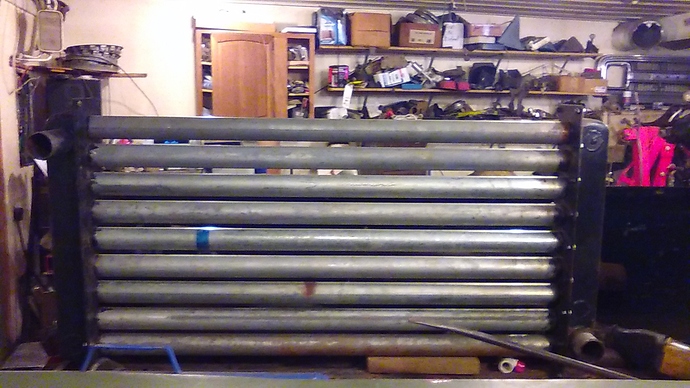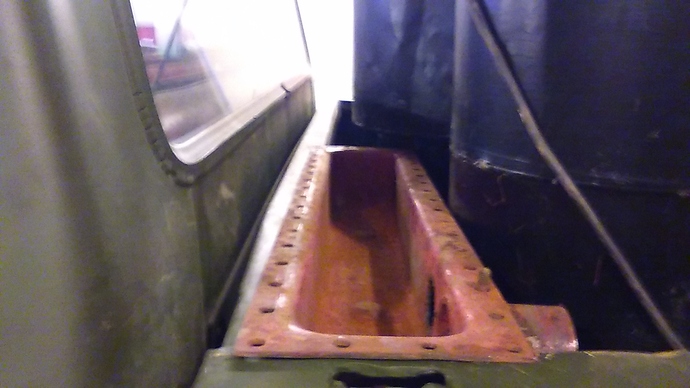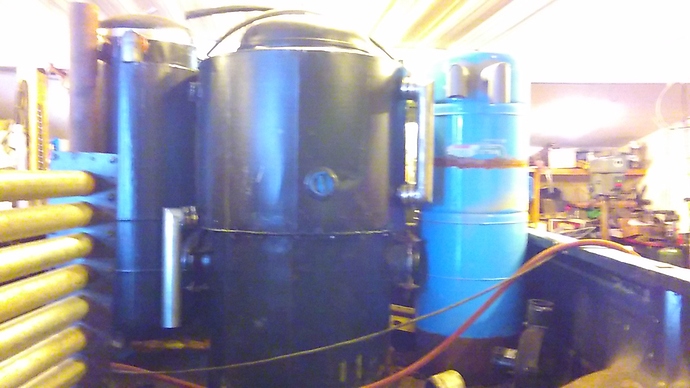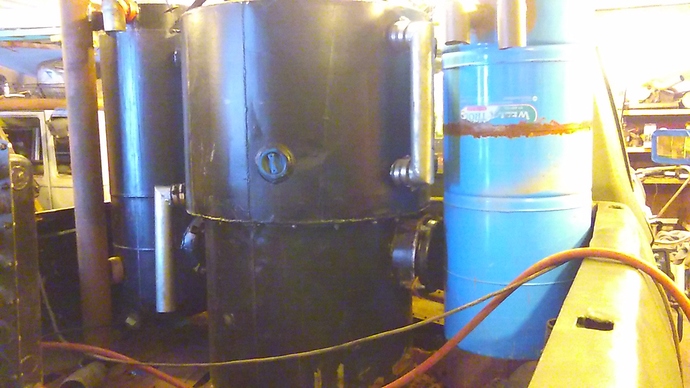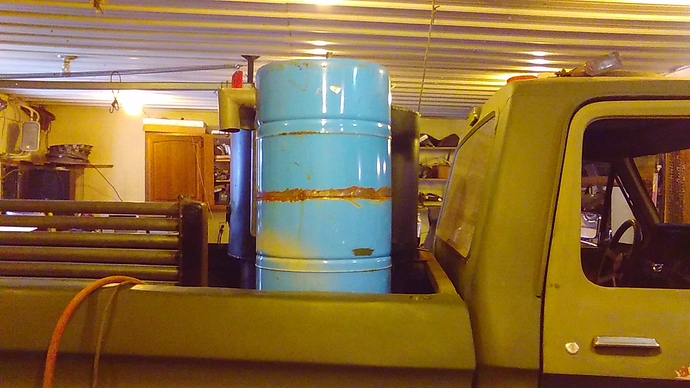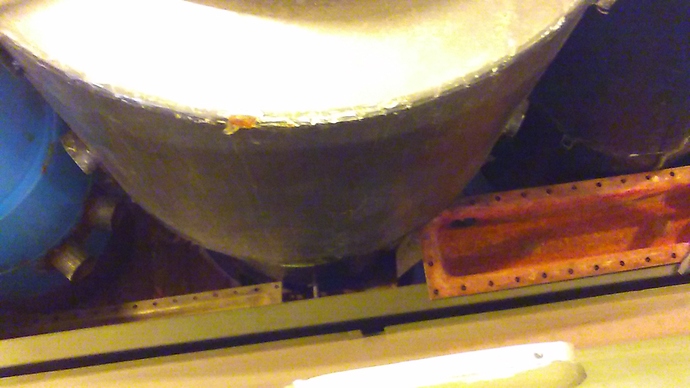I have not driven a singel meter on woodgas (yet) but I am curious if have missed something here.
What has power to do with if you are a bit low on cooling area (rails)? Would that not only mean more condensate will appear later in the system (hay filter). As long as the gas is cool and dry when it enters the engine one should be fine, right?
@JO_Olsson I’m guessing that it’s assumed that of your cooling rails are too small to give cooling, then they are too small to give flow/breathing to the gas for high-end needs (pulling a load up a hill or whatnot).
Hello JO. Long time no talk. I believe Max is talking about cooling all the way from the gasifier to the engine. Pulling hard on the engine ( WOT) creates more heat and you have to have more surface to cool it — be that surface in a traditional Imbert type cooler / filter or cooling rails, but it includes the piping to the engine and possibly the heat exchanger and hay filter— the entire system is figured in.
Yes as long as the gas is cool and dry it should be fine. BUT, I like to heat my gas back up just a little to get it to hold any moisture that I didn’t get out in the previous part of the systemTomC
Thank you, Brian and Tom !
Reading posts again, now when I’m no longer in a hurry, I realise I reacted to something that isn’t there.
Hi, Jim!
Your 18 pcs. 2" diameter, 2’ long tubes represents slightly less than 19% of the estimated summertime total cooling surface.
It might suffice in VERY cold circumstances, but the hard problems come AFTER that deep cooling; the cooling continues “without asking permission” making ice-pellets and ice-grain in the following passages.
So, before or at least after the INSULATED (hay)filter you have to reheat the gas substantially in a welded-on mantel welded on the heatexchanger!
IF you reheat the gas before the (hay)filter, you will re-boil most of the latent water bound in the filter material and on the bottom!
That is NOTHING a motor wants to start on, or run on if force-started on gasoline… and steam-bathing!
This is the only way to deliver warm and dry gas to the motor, through an INSULATED tube to the motor.
Max
Thank you for the clarification on throttle position while driving Chris, seems the truck will outrun the gasfire . I get it, being the fuel is now a gas and rather than liquid. The passages not large enough to fill cylinders completely. Max, thank you for your help here. I will set this cooler aside for another purpose. It seems all this insulation on tanks and plumbing must be seasonal or I will need 200, of pipe. My reheat mantel, could this be on my 3 1/2 " pipe from heat exchanger to condensate tank. Probably better to make another heat exchanger here . Hot gasses to the outside ,cooled gas reheated to the center?
"
Hi, Jim!
Now, it is easy to give bad suggestions on wrong assumptions, before your general and detailed pictures are available…
Don’t rip off the cooler yet; at least not before photoing and allowing some tests; results are valuable now when it’s cold.
The reheating of the cooled gas may need a bigger heatexchanger area on a hotter surface… if one gets too much reheat, it is easily “diluted” with a parallel cold flow tube with a regulating flap, joining and mixing back into the hot flow after the heater.
But, pictures puts one on “safer ground” for suggestions…
Max
Thank you Jim!
Still, a picture from the back-end of the flatbed, and one from above would give a total image of the arrangement.
It helps to see where a reheater can be placed.
It seems like your current cooler’s “bottom
pan” fits excellent in front of the (hay)filter?
Is it the same one as in the other picture of the “all in one piece” cooler?
Don’t cut the vertical tubes before a practical test is done! The results of the test are valuable!
Test results are manifold better than imaginations!
They “calibrate” the planning forward.
Max
Tthis opening will be the place to get the heat needed. Another heat exchanger, say from gas furnace on a box. Hot gas to condensate tank reheating gas from cooler below hay filter. Blue filter in pic can be replaced and used in next system in a Dakota.
Thanks, Jim!
Until you have installed the right side heatexchanger there is no reason to suggest new items, I think.
Here seems to be items needing some “specification”, before commenting…
Max
Max , until you suggested reheating the gas I had no intentions to have another heat exchanger there at this time. This is my first gasified truck. I have never even driven it on gasoline yet. When I started building this gasifier I was uncertain of its mate so I left options. The lower drum is galvanized an don’t want to have to weld on it again. Even if I do not reheat now I like to plan ahead so future mods can be added in modules. At this time it looks like a good place to add another cooling module with a reheat exchanger module option a planed easy add on. I respect and value your opinion and thoughts on this. Thank You , Jim
Looks like you went with home built barrow, you got a darn good start at it, i bought a quart of BBQ paint from true value hard ware the other day,now i got too get my tubeing lined up for hopper cooler.So i can sand and paint inside the hopper too keep the metal good longer [Looks good].
Hi Jim!
Even to the point when you presented your first picture (the cooler bottom), I thought that your layout was identical with the WK system.
Meaning, that the middle barrel was the heatexchanger, left one (hay)filter, etc…
Now, with the intake-air heatexchanger to the left, is the right hand opening on the gasifier providing both gas out and primary air intake, as on the left side?
Anyway, according to my misconception, I was thinking of welding-on an extra layer on the “heatexchanger in the middle” as the outer skin of a reheat exchanger, “stealing” heat from the underlaying hot gas.
This way no extra component had to be built, taking precious space…
Now to the reality of more pictures: Applying this welding-on flat and part-circular, bent around (seen from above) box on the lefthand real heatexchanger for primary air, removing any insulation first of course, will spare a lot of room.
Furthermore, you do not need to use the righthand outlet on the gasifier; saving the space to the right of the gasifier for a (hay)filter, or whatever is needed.
Max
Sorry for the poor pics Max. It is a slightly modified WK. The reactor is just in the center to make things work better below. The Heat exchanger is left. It is also designed to accept another on the right. This was in case I wanted to use it on another application or set it up as a true duel system as Herbs Caddy . Down the road I thought it may be fun for side by side HX comparisons. As in everything I do I like to have a back up plan. The condensate tank is under the bed floor on the far left and built to be insulated easily The exhaust HX is under the left side of the reactor and hopper condensate bin will sit above bed between HX and reactor. A reheat shell on HX is possible. How does on calculate the size needed? What about water? Does it have to drain to the hay filter in the gas piping. Thank you. Off to the salvage yard for materials today.
Hi, Jim!
The HX to reheat area approximately 15 – 20"sq per liter displacement. Wet shunt tube with flap.
It is always beneficial to have a small manual drain.
Max
“Wet shunt tube with flap” could you please explain this? 15- 20 square inches per liter of displacement. Engine displacement? that seems awful small? I am sure velocity must play an enormous roll in reheating as well as cooling?
Hi, Jim!
Yes, ~2 days back the parallel tube for unheated, damp gas with a regulation flap was described.
If the reheater makes the cool, damp gas unnecessarily hot, it can be modified (cooled) with some cool & wet gas which is parallelling (bypassing) the reheater and then mixed in with the “too hot” gas to achieve the wanted temperature.
The flap has to be well centered on its axis in order to stay neutral against “flowpower”. Otherwise a setting can go out of hand…
Yes, the reheating area is determined by the motor displacement.
In fact, the air preheating around the firetube and in the heatexchanger
will “take back” about half of the heat energy leaving the grate-area.
Because of this, it is a good precausion to increase the reheating area for the wet & cool gas to:
31"2 per liter displacement
31"2 X 4,7 = 145,7"2 or ~150"2
150"2 = 1,041667’2
The reheater mantel around part of the heatexchanger cylinder would be ~1" thick.
This seems to be enough; the increase in temperature needs not to be very big, even if the reheated gas has to take the “burden” of the cold secondary air at the mixer. Otherwise cold and heavily humid secondary air can lead to condensation again.
All this counts at a deep frost startup without gasoline.
And the delivery tube/metal hose from the reheater to the mixer has to be insulated.
Max
